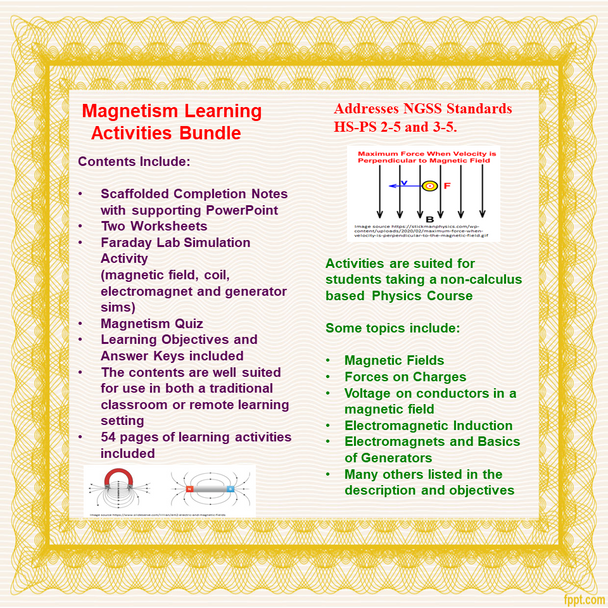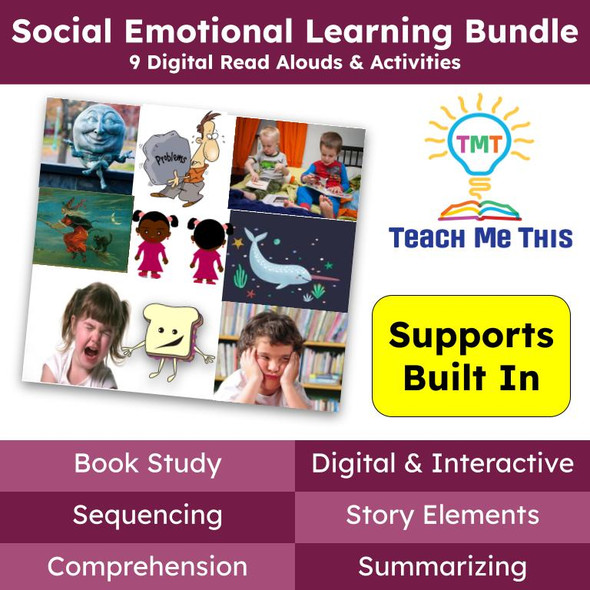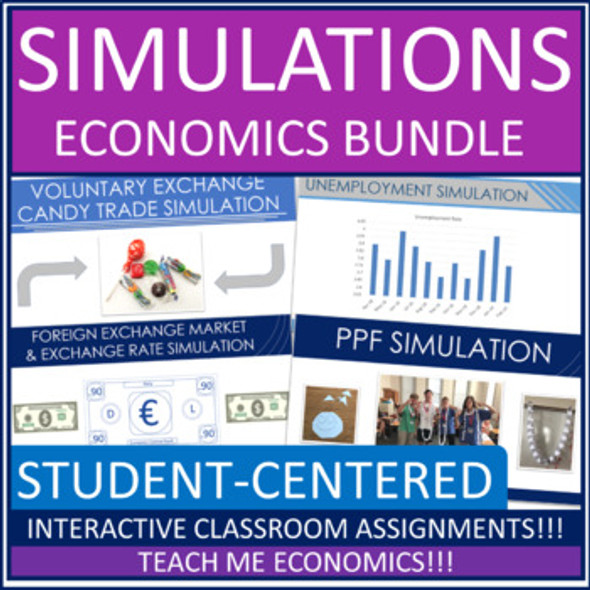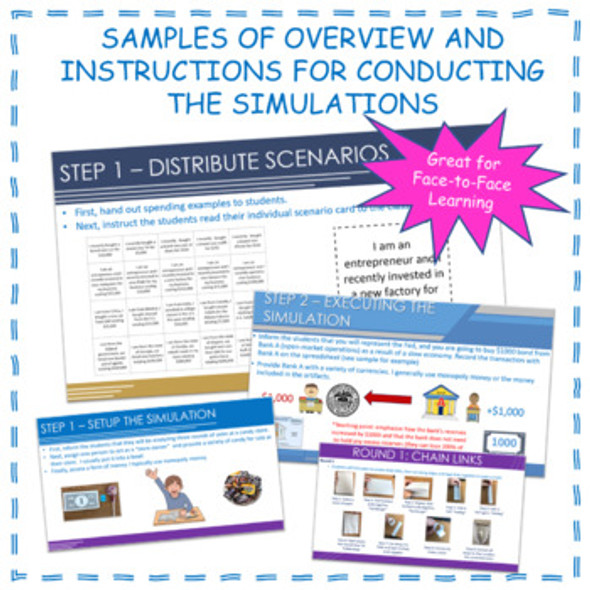Description
The content contained in this learning bundle provides materials to teach a magnetism unit in a high school physics class. This bundle contains 12 pages of scaffolded completion notes with a supporting PowerPoint, two worksheets, a quiz, and two lab activities. With the exception of the PowerPoint all documents are available in word (which easily edits to meet your needs) and pdf formats. Answer keys are included for all items. The bundle contains the PowerPoint and 54 pages of learning materials. Answer keys are not included in the page count. The specific contents of the bundle are listed below:
- Magnetism Scaffolded Completion Notes (12 pp.)
- PowerPoint to accompany the Scaffolded Completion Notes (31 slides)
- Magnetism Worksheet 1 (43 completion, true-false and multiple choice questions) (7 pp.)
- Magnetism Worksheet 2 (34 completion and multiple choice questions) (6 pp.)
- Magnetism quiz (33 questions) (8 pp.)
- Electromagnet Video and Lab Activity (6 pp.)
- Faraday pHet Simulation Lab Activity (includes bar magnet, pickup coil, electromagnet and generator activities) (16 pp.)
Topics including in this learning bundle include; law of magnets, bar magnets, calculation of voltage in conductors moving perpendicular to a magnetic field, the earth's magnetic field, magnetic declination, Oersted's discovery, forces on charges moving perpendicular in a magnetic field, magnetic mapping and flux, electromagnetic induction, electromagnets, generators and many others.
The contents of this bundle are well suited for use in a traditional classroom. They may also be easily utilized to support remote learning situations.
NGSS Learning Standards
HS-PS2-5. Plan and conduct an investigation to provide evidence that an electric current can produce a magnetic field and that a changing magnetic field can produce an electric current.
HS-PS3-5. Develop and use a model of two objects interacting through electric or magnetic fields to illustrate the forces between objects and the changes in energy of the objects due to the interaction.
Common Core State Standards Connections:
ELA/Literacy
WHST.9-12.7 Conduct short as well as more sustained research projects to answer a question (including a self-generated question) or solve a problem; narrow or broaden the inquiry when appropriate; synthesize multiple sources on the subject, demonstrating understanding of the subject under investigation.
WHST.11-12.8 Gather relevant information from multiple authoritative print and digital sources, using advanced searches effectively; assess the strengths and limitations of each source in terms of the specific task, purpose, and audience; integrate information into the text selectively to maintain the flow of ideas, avoiding plagiarism and overreliance on any one source and following a standard format for citation.
WHST.9-12.9 Draw evidence from informational texts to support analysis, reflection, and research.
Mathematics
MP.2 Reason abstractly and quantitatively.
MP.4 Model with mathematics.
HSN-Q.A.1 Use units as a way to understand problems and to guide the solution of multi-step problems; choose and interpret units consistently in formulas; choose and interpret the scale and the origin in graphs and data displays.
HSN-Q.A.2 Define appropriate quantities for the purpose of descriptive modeling.
HSN-Q.A.3 Choose a level of accuracy appropriate to limitations on measurement when reporting quantities.
HSA-SSE.A.1 Interpret expressions that represent a quantity in terms of its context.
HSA-CED.A.1 Create equations and inequalities in one variable and use them to solve problems.
HSA-CED.A.4 Rearrange formulas to highlight a quantity of interest, using the same reasoning as in solving equations.
Learning Objectives
Upon the completion of this unit the student will be able to:
1. recognize the spinning electrons of the atoms in a magnet are aligned with each other.
2. compare and contrast temporary and permanent magnets.
3. recognize some permanent magnets are made of alnico.
4. recognize the magnetic force of a magnet is strongest near its poles.
5. recognize like magnetic poles repel and unlike poles attract.
6. explain what is meant by the domains of a magnet.
7. recognize that pieces of iron and steel can be easily magnetized.
8. define the term ferromagnetic.
9. recognize the earth is a magnet that produces a magnetic field that is strongest near its magnetic poles.
10. recognize the earth's magnetic north pole is really a south pole and that the earth's magnetic south pole is really a north pole.
11. recognize the earth's magnetic and geographic poles are not in the same location.
12. explain what is meant by magnetic declination.
13. recognize that compasses are magnetic.
14. recognize that electric currents in the earth's molten iron and nickel outer core are responsible for the earth's magnetic field.
15. recognize the earth has undergone many geomagnetic reversals in its past.
16. recognize magnetic fields are found elsewhere in our solar system.
17. recognize sunspots are found on the spots on the sun's surface where its magnetic field breaks through its surface.
18. recognize intense sunspot activity is often associated with disruptions in the earth's radio and television communications.
19. explain what is meant by the magnetosphere.
20. explain what is meant by a magnetic field.
21. recognize that magnetic fields exert a force on charges moving in them.
22. explain what magnetic flux lines indicate.
23. recognize iron filings can be used to map a magnetic field.
24. properly draw magnetic flux lines representing simple magnetic fields.
25. define direction in a magnetic field.
26. define the term magnetic field strength or flux density.
27. recognize magnetic field strength is a vector quantity.
28. know the tesla (T) is the SI nit for magnetic field strength.
29. utilize the formula F=qvB to calculate the force on a charge moving perpendicular to the direction of the magnetic field in the magnetic field.
30. explain what is meant by electromagnetic induction.
31. discuss how electromagnetic induction is utilized in the functioning of generators.
32. discuss the basic energy conversions involved in a generator.
33. utilize the formula V=Bℓv to calculate the voltage induced in a conductor moving in a direction perpendicular to a magnetic field.
34. recognize that if the flux lines in magnetic field are cut by a conductor in a complete circuit, a current will be induced in the circuit.
35. recognize a conductor moving parallel to the lines of flux in a magnetic field will not have a current induced in it.
36. recognize that moving electric charges produce electric and magnetic fields that radiate into space as waves.
37. briefly explain what is meant by an electromagnetic wave.
38. discuss Oersted's discovery involving current carrying conductors and a compass.
39. explain what a solenoid is.
40. discuss how to make a simple electromagnet.
41. list four factors that increase the strength of an electromagnet.
42. list several uses of electromagnets.
Terms of Use
Purchase of the product is for classroom use by the purchaser only. I do encourage you to use and edit these documents to suit your needs with your own students in distance learning environments.
This work is licensed under a Creative Commons Attribution-NonCommercial-ShareAlike 4.0 International License.

















